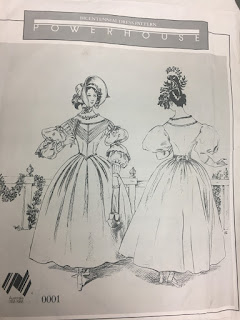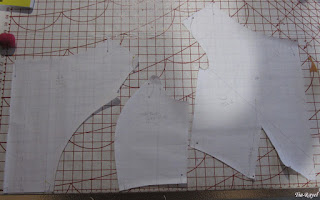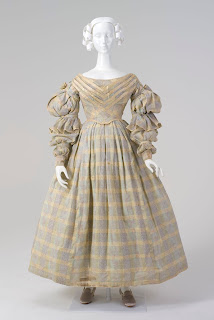So,
Jafa was coming round again and I needed a new dress to wear. And,
as usual, it turned out the dress I wanted would require new stays. Not having the time (or, frankly, the inclination) to rush both stays and dress before April I started looking for something I could make to go with the late 1820s/early 1830s stays I have.
Way back in highschool my homegroup teacher gave me this pattern when she was clearing out her stash.
 |
| Powerhouse Bicentennial dress pattern 0001 |
The pattern had been produced by the Powerhouse Museum as part of Australia's Bicentennial celebrations (before I was born). The pattern is taken from
this dress in the museum's collection.
I had long wanted to make this dress but had been putting it off until I was a good enough sewer to do it well (and until I had made a corded petticoat to go with it). So I got the pattern out, found that the fabric I had been considering was discontinued years ago, and decided to look for something else.
Then, wandering through Lincraft looking for artificial flowers I found the perfect fabric. It was so close in style to 30s' prints that, at $7.50 a metre, I bought the bolt. I think it's cotton; a burn test assured me that it was a natural fibre but my nose is not specialised enough to determine further – the store had it classified as 'assorted fabric'.
 |
| Samples of actual 30s’ prints can be seen here |
Next, I traced off the pattern. The pattern is not quite like a normal pattern. There are non-standard markings for things like notches and folds and some of the other markings I was looking for weren't there at all. The lines are very thick so it must be almost a change in size depending on whether you trace off from the inside or the outside of the line. The instructions also are not step by step and don't have a lot of detail about the actual sewing. I wouldn't recommend this pattern for a beginner but If you’re happy to do research alongside, the pattern is still quite usable. (Although I do suspect the pattern makers of making some changes from the original dress to make things easier – like laying some pieces on the fold instead of piping all the edges, and possibly reducing amounts to be pleated.)
My measurements were pretty close to the pattern so I made no adjustments before putting together the first mockup.
This fitting was very different from fittings I've done in the past. Because of the lessons I have been doing I now know what signs of ill fitting to look for and what to do about fixing them. I recognised that the tightness in my shoulders required a square shoulder adjustment. Comparing the wrinkles on the mockup to the drawings in
Figure Analysis*, I worked out that the pattern also required a small bust adjustment. It was a wonderful feeling to look in the mirror and see a bodice that didn't fit but also to know what I could do about it. I am looking forward to a future where clothes no longer hurt my shoulders. Small bust adjustments have not yet been covered by my sewing classes but I was able to use the techniques already taught to understand the instructions from
Pattern Alterations*. The only uncertainty was what to do with the dart but after some consultation with a friend we worked out what to do (move it up so the whole length of the dart was kept.
 |
| 2nd last fit - adjustment to darts needed |
 |
| Original pattern |
 |
| Adjusted Pattern |
*both by Pat Fernon. These are the textbooks for the fashion design course at our local TAFE (vocational) college. They are published by TAFE and are not the easiest things to come by.




